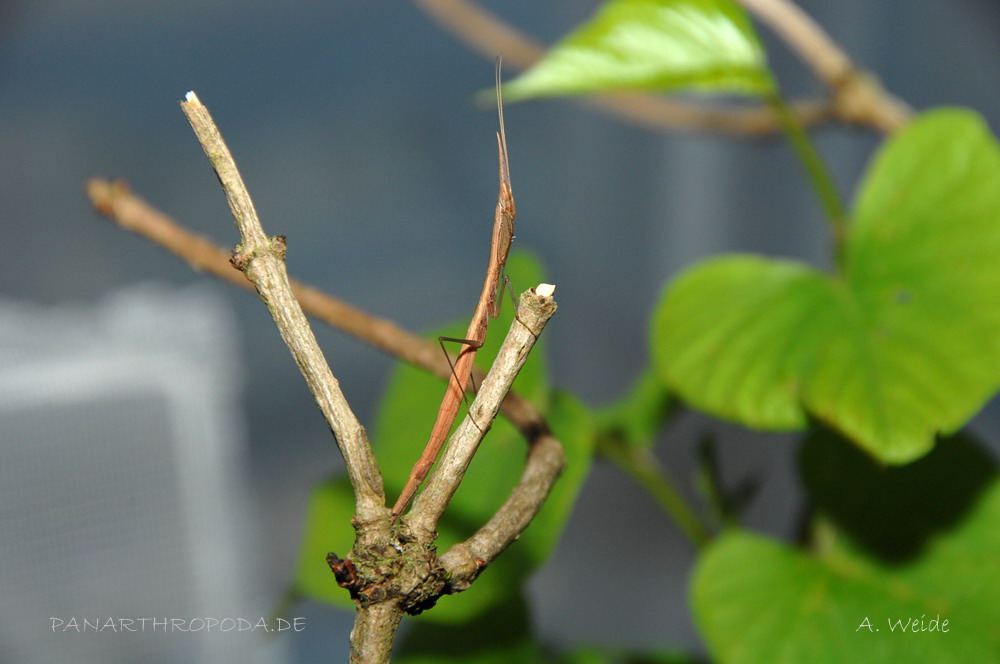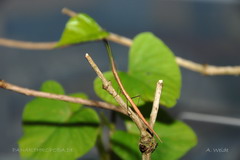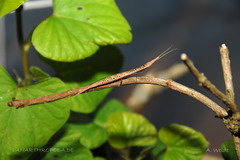- Acanthopidae
- Amorphoscelidae
- Empusidae
- Eremiaphilidae
- Hymenopodidae
- Iridopterygidae
- Liturgusidae
- Mantidae
- Metallyticidae
- Sibyllidae
- Tarachodidae
- Thespidae
- Toxoderidae

Didymocorypha lanceolata (Fabricius, 1798)

Adult male
Origin and occurrence
Didymocorypha lanceolata has been found in India, Nepal and Sri Lanka. My specimen originated from the indian state Goa (IGM-Nr. 101).
Appearance and sexual dimorphism
This species has a bizarre body form, which is similar to a twig or a straw. This pretence is amplified by the long vertex-extraction, which almost desolves the contures of the head. Didymocorypha lanceolata is colored light-brown to beige and can show black dots on the dorsal side of the body.
The sexes can easily be distinguished by the wings in the imaginal state. Whereas the males will have wings, they are totally reduced in females. In addition, the females will get bigger (3,5 cm) than the males (3 cm). The larvae can be sexed only by counting the abdominal segments, where males have 8 and females 6.
Behavior
Didymocorypha lanceolata is extremely skittish. The animals will sensetively react to disturbance and run around right after opening the container.
Aggression inside groups is practically not developed, because of which they can be kept in groups. I did not encounter any cannibalism.
The males are proper flyers, which one should keep in mind when opening the container.
Keeping conditions

Adult female with black dots
In corrospondence to the origin they should be kept at 25 to 32 °C during day and about 20 °C during night. A high humidity is not necessary, spraying every 2 to 3 days is absolutely sufficient. The container should contain slender twigs, possibly with leafs. No substrat is needed, paper towel is fine, but humus or something similar can be used, too.
Keeping this species solitarily is not necessary. About 5 to 6 adult specimen can be housed in a container measuring 20x20x20cm.
The can be fed with Drosophila hydei, Didymocorypha lanceolata can not prey on much bigger animals due to its delicate raptorial legs. Houseflies can be used, too, but green bottle flies should be too big. I fed my adult specimen with D. hydei.
Mating and raising the young
Mating Didymocorypha lanceolata offers no problems. The animals are sexually mature within 1 to 2 weeks and ready for mating.
In my case, the Oothecae have been yielded at 30 °C during day and 20 °C during night. 4 to 5 weeks later the young (between 4 and 5 of them) hatched. Due to their small size, they have to be fed with Drosophila melanogaster. After several molts they will prey on D. hydei, too.
Due to the small litters it can be assumed, that the conditions for yielding or even the keeping conditions are faulty. Since my breeding line died out rather quickly (because of the small litters), I have been unable to do further testing. But other keepers report of litter sizes up to 20 under the same conditions.
Diagnosis
Didymocorypha lanceolata with its bizarre habitus is an interesting animal to keep, that in addition only needs little space. Feeding Drosophila spp. is nevertheless necessary, at least for smaller larvae, which scares off many keepers.
A. Weide



